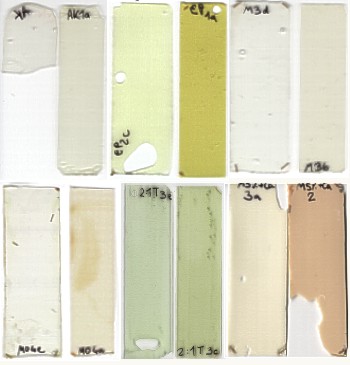Hochschularbeit
| Olaf Pung: | Study into the suitability of reactive methyl acrylate adhesives for the conservation-restoration of museum stone objects. | Zurück |
| Sprache: | Original - Übersetzung | |
| Seitenübersicht: | ||
 samles of adhesives before and after thermal ageing
|
|
| Zusammenfassung: | Nowadays, reaction adhesives on the basis of epoxy and polyester are commonly used in stone conservation. The starting point of this work is the fact that these adhesives fail to meet the reversibility requirement, which is generally accepted in conservation science. Certain reactive resins on the basis of methyl methacrylate (MMA) may constitute an alternative: Although these have the advantages of reaction adhesives, no thermosetting plastic is formed during the curing reaction as happens in the case of epoxy or polyester, instead the thermoplastic polymer polymethyl methacrylate (PMMA) is formed. It can be softened using heat or organic solvents such as acetone, which is why it is possible to disjoin such a bond later. This work consists of a theoretical and a practical part. The first part explains the curing reaction of this adhesive, listing its specific components and their functions. The physical properties of PMMA are described and compared to those of natural stone. The practical part of the work assesses the properties of the following reactive resins: an MMA-based stone putty an epoxy adhesive an MMA casting resin, intended for embedding and microscopic preparation various self-formulated MMA adhesives The following parameters of these adhesives were examined: tensile strength of the synthetic resin as such tensile adhesive strength, as measured by means of bonding objects consisting of limestone and adhesive pot life reactive shrinkage solvability after curing In order to assess the ageing performance of the adhesives, their solvability and tensile strength were tested after 28-day artificial ageing at 70°C. The following results were achieved thereby: Reactive MMA adhesives with no cross-linking additives are basically suitable for bonding museum stone objects. However, in comparison with epoxy resins, their short pot life and their weaker adhesion constitute a problem. The long-term durability of these adhesives is excellent. Over an extended period of time, neither shrinkage, nor degradation, nor loss of solvability are to be expected. No MMA reactive resins could be found on the market which are explicitly meant to be used as adhesives and which comply with the demand for resolvability. Although there are two casting resins with the sought properties, the processing system of these products is not particularly suited to applying them as an adhesive. Superior properties could be shown for one of the self-formulated products. Also, its pot life is a little longer. The experiments demonstrated that wetting could be improved by preparing the adhesion surfaces, applying a low-viscosity adhesive mixture. The common objections against thermoplastic adhesives, specifically, that these tend towards "cold flow" and are therefore unsuitable for bonding heavy stone parts, could be invalidated by a model calculation. A formula for an MMA reactive resin which the conservator can prepare himself is proposed. |
| weitere Angaben: |
|
| Kontakt: |
Olaf Pung Mendiger Straße 9 56743 Thür Deutschland |
| Anmerkung Autor/in: |
aktualisiert: 11.05.07. Zur Praxiserfahrung mit dem Klebstoff habe ich einen Zeitschriftenartikel publiziert, siehe http://193.175.110.9/hornemann/german/epubl_aufsaetze52.php |
| Download: |
Volltext der Hochschularbeit (pdf-Format, ca. 1.1 MB) |
| DOI (Digital Object Identifier) | 10.5165/hawk-hhg/epublication/20 |
Das Hornemann Institut verfügt ausschließlich über die hier angezeigten Informationen. Für weitere Informationen oder Kopien der Hochschularbeit wenden Sie sich bitte an den Autor/die Autorin - oder wenn kein Kontakt angegeben ist - an die Sekretariate der jeweiligen Fakultäten.